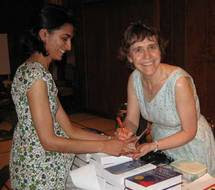 |
Photo by Kees Streefkerk on Unsplash
|
Because
English speakers have been such enthusiastic borrowers from other
languages throughout our history, our spelling is notoriously
non-phonetic. It causes grief to both native speakers and
second-language learners. But its sheer quirkiness has contributed to
what we can only call a “language as parlour game” phenomenon:
English speakers love to test their linguistic mettle (or is that
“metal”, or “meddle”, or “medal”?) in games like spelling
bees, and our many homophones make the language a fertile source for
punsters.
(How
are you doing on those “SEE” spellings? Are you up to 10 yet?
There are more!)
English
is a wacky language. Lunatic, even. Consider how many ways we can
write the sound “TOE”.
In
a sensible language, it would be written “to”. But no, not for
us. The digraph “to” is pronounced “TOE” in some words, but
when to
is
a word unto itself, it is pronounced “TOO”, not of course to be
confused with two
or
too,
dear me I am feeling faint.
pto ptomainetau taupeteau plateauteaux Saulteauxtho Thomismto potatotoa toadtoe toetoh butohtot Pitottow towtto ditto
(12 spellings)
“Twelve
spellings,” you think, “But that's ridiculous!” (By the way,
how are those “SEE” spellings coming along? There are more than
twelve!)
Okay,
then. Or should I say, “Oqué!” Because, for the sound in “okay”
we have:
ca cabercai caimancay decaycca occasioncei ceilidhcha chaosk KOka kaolinkay okayke keakei keiretsukey Keynesiankka Akkadianqa qadiqué appliquéque quesadillaquet bouquet
(17 spellings)
Seventeen??!!
Surely there (not “their” or “they're”) can't be more for
“SEE”!
Think
again!
And
while you're mulling on that, let's talk about homophones some more.
Our old confusable friends affect/effect, desert/dessert, and
principal/principle are problems for all English speakers. But what
are homophones for Canadians are not necessarily homophones in other
varieties of English.
For
instance, khat
(an Arabian shrub the leaves of which are chewed as a stimulant),
cot,
and caught
are all pronounced the same in Canadian English but differently in
Southern Standard British English (where, what's more, caught
is
a homophone of court,
and khat
is a homophone of cart).
A
particularly interesting phenomenon occurs when a vowel precedes the
letter “r”. For most Canadians the words harry
and hairy
are
perfect homophones. Dictionaries from other countries would fail to
warn you about this.
It's
not just the vowels that are a problem, though. In North America we
tend to pronounce the letter “t” between two vowels or before a
syllabic “l” as “d”; hence it is possible to confuse tutor
and Tudor
or hurtle
and hurdle. I once was very confused by a discussion with a lawyer where he seemed to be referring to the company infringing someone else's trademark as a "traitor". "That's a bit harsh," I thought, till I realized the word he was using was "trader"!
You might think,
“Well, really, who would ever confuse tootsie
and Tutsi?”
But bear in mind that in a spelling bee, a contestant is given the
word orally out of context, so they have no way of knowing, when
they hear the sound “TOOT see” (there, I've just given you two
spellings of “SEE”!), whether piggies going to market or African
peoples are meant. There are many more homophones than you probably
suspect: we identified 1800 of them in the Canadian Oxford Dictionary.
To
keep you entertained while you're still working on your “SEE”
list, here are some other syllables in English with wildly variant
spellings:
The
choux is on the other foot:
choux choux pastesciu prosciuttoshoe shoeshoo shooshu Shuswapsu sensualtu punctualxu sexual
(8 spellings)
Jai
thee to a nunnery:
ha'i Baha'ihai Haidahay Haydnesquehei heinieheigh heighthi hihie hiehigh highhy hyacinthjai jai alai
(10 spellings, 11 if we also count chai in l'chaim)
Heaving
a sci:
ci citecy cyanpsi psipsy psychsai saigasay sayonarasci sciaticscy scythesi sitesig signsigh sighssai assaissi Messiahsy prophesyxi xi
(15 spellings)
For
a small phoe:
fae faecesfe febrilefea featfee feeffee coffeeffei caffeineffi graffitiffy taffyfi fiascofie fieffil filsfille fille de joiefilles filles du roifit confitfj fjordfoe foetusfy salsifyghie toughieghy roughyphae nymphaephe phenolphee biographeephi morphinephoe phoebephy philosophy
(a whopping 25 spellings)
But
“SEE” trumps them all. This is your last chance. Exhausted all
the possibilities you can think of?
There
are THIRTY-ONE different spellings of SEE” in English!
From
cey to coe:
c C-section
cae Caesarce cedecea ceasecee Sadduceecei receivecey Ceyloneseci calciumcie policiescoe coelomcy icysce scenesci hyoscinese sebumsea seasee seesei seizesey curtseysi Tutsisie siegesse Tennesseanssee lesseessey odysseyssi lassissie lassiessy sissysy hypocrisyxe tuxedoxi taxixie pixiexy boxy
I
can only conclude that all of us who have to write English,
especially those of us who make our livings in the language
industries, deserve a meddle, dammit, I mean medal for putting up
with this chaos.
If you would be interested in taking my Rollicking Story of English course in January and February, please let me know (wordlady.barber@gmail.com). It would be a weekday morning or afternoon in Toronto (let me know which days and times suit you best). 9 weeks, $280.

No comments:
Post a Comment